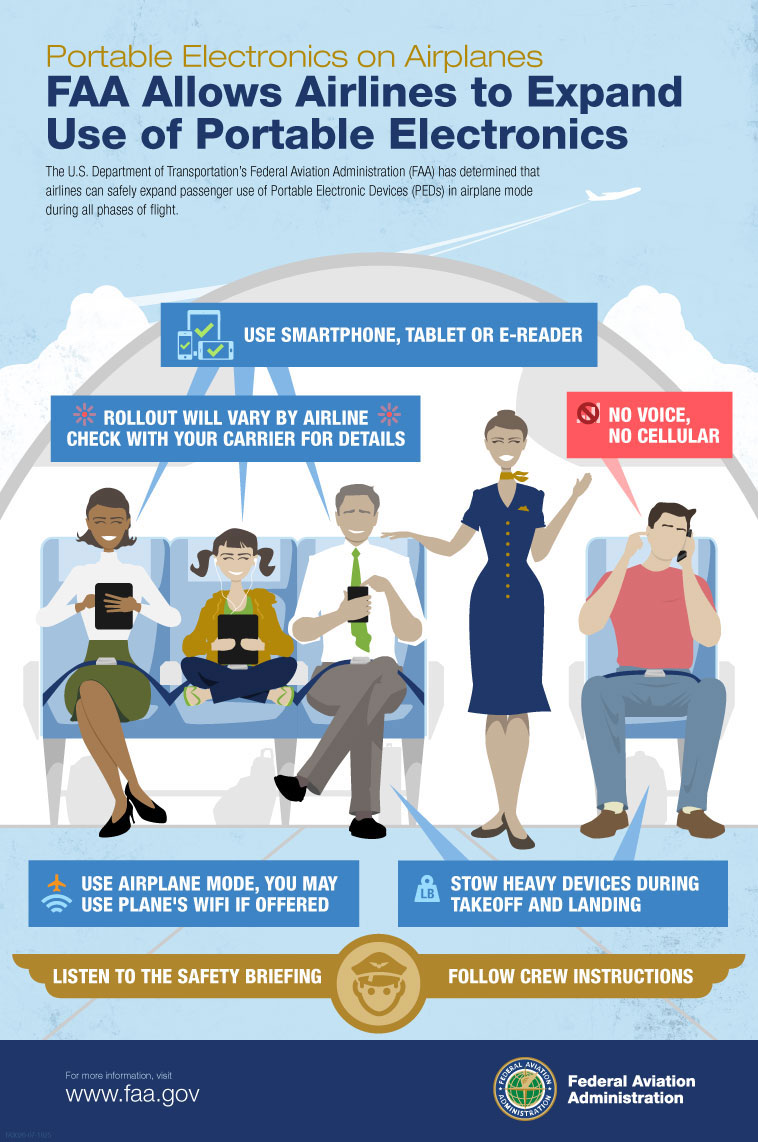In 2012, the US Federal Aviation Commission (FAA), issued an update on new rules concerning the use of Personal Electronic Devices (PED). Using iPad, iPhone and most portable electronics during taxi, takeoff and landing, is fine, as long as said devices do not use cellular networks, and as long as the devices are approved by the operator of the aircraft.

This latter caveat means that each operator is allowed to set specific rules on how, and when to use you iPad, iPhone or MacBook, while on board. With that said, very few airline operators have put any particularly strict restraints on passengers wanting to use their devices while on board.
By the time the iPad Pro is commercially available, the rules are unlikely to change, however it’s always recommended to check with your operator of choice. The following list includes US airway companies that let you to keep your device turned on, as soon as you are boarded:
American Airlines
AA allows passengers to use iPad, iPhone and most electronics, provided they don’t access cellular networks. Wi-Fi connectivity is provided by Gogo, which offers day passes, and monthly subscriptions for international and domestic flights. The price for a domestic day pass (24hrs) is $14. On international flights, passengers can purchase a two hour pass for $12, or pay $17 for four hours, or $19 for the duration of the flight.
Delta
Much like AA, Delta passengers will be able to use their devices during all phases of operation of the aircraft, sans cellular access. Gogo’s rates however a slightly different, since using the new 2KU satellite service, offering a $49.95 unlimited monthly package, or a $469.95 annual pass available on all domestic flights.
Frontier Airlines
Passengers of Embraer 190 aircraft will be able to use tablets and smartphones, by connecting to Gogo’s $14 day pass, or with a $5 1-hour pass on single domestic flights. Traveler Pass allows $39.95 monthly access for unlimited Internet.
Jet Blue
Want to stream Netflix movies on your iPad? Jet Blue has come up with a clever way of providing Wi-Fi access to passengers of all A321, A320 and E190 aircraft, by offering $9/hour streaming, available as an add-on service when using the free Fly-Fi, Simply Surf basic onboard Internet service.
Southwest Airlines
Southwest will let you surf the web on iPad, iPhone or Android devices, on its entire fleet, all day, for $8, per device, through Row 44. It’s unclear whether the service allows streaming of TV shows and movies through apps like Netflix.
United
Passengers of all Boeing 747 and 757 routes between New York, Los Angeles and San Francisco, as well and all A319 and A320 aircraft, will be the first to be able to use their new iPad Pro devices, as United prepares to extend Wi-Fi access to its entire fleet, through Gogo, at similar rates as other Gogo-equipped airlines.
US Airways
When flying on any US Airways Airbus A321, A320, A319 and Embraer 170, 175 and 190, which is currently 90% of US Airways fleet, passengers will be able to surf the web and stream their favorite shows on their iPad Pro, and all their favorite devices, all day, for $14 (24hrs pass), or $39.95 per month.
Virgin America
Starting at $2 per 30 minutes access, Virgin America travelers will be able to use their devices to connect the the Internet, on the company’s entire fleet, as soon as they are seated. The service is once again provided by Gogo, with the same standard 1-hour rates, with day pass and monthly subscription.
Will the iPad Pro turn planes into flying office buildings?
The latest trends in mobile devices, particularly regarding touchscreens, is that display sizes are getting bigger, and the line between tablet and laptop is getting blurred. This is particularly true when looking at devices like the iPad Pro, and Microsoft Surface Pro 4. Both devices have a small enough footprint to fit comfortably on a tray, and enough processing power to get work done.
By this token, a long-time problem in connection with working with a laptop while sitting on an aircraft, is about to be solved. Up until now, depending on the size of the laptop, the flight crew might require passengers not to place the laptop on the tray, but rather rest it on their lap. This is due to the fact that during flight, G-forces may cause a device normally weighing 3-5 pounds, to multiply its weight, when climbing to a higher altitude, and potentially wear, or break the plastic trays normally designed for meal consumption and other lightweight activities.
The recommended size for a laptop to sit on a tray on the back of an airplane seat in economy class is under 14 inches, with a weight under 2lb. Devices like the iPad Pro, or Surface Pro 4 offer a much more comfortable way of using tablets, that is more laptop-like, through the use of a keyboard, and a stylus, to add more precision when working within apps like Microsoft Office 2016, or other productivity tools.
The display on devices like these is under 14 inch, and can be stored quickly during emergency operations required while encountering certain flying conditions, such as air turbulence.